-
 Title page: PARIS | À TABLE | PAR | EUGÈNE BRIFFAULT. | Illustré par Bertall. | {vignette} | PARIS | PUBLIÉ PAR J. HETZEL, | RUE DE RICHELIEU, 76 — RUE DE MÉNARS, 10 | 1846 || Pagination : ffl, [2] – h.t. / imprim., [2] – wood-engraved pictorial t.p. bt Bertall, [2] – t.p. / blank, [i] ii-iv, 2] – f.t. / imprim., [1] 2-184, ffl; in-text woodcuts by Betrall. Collation: π6 1-462; size 8vo. Binding: brown quarter morocco over marbled boards, raised bands, gilt device in compartments and gilt lettering to spine. Matching marbled endpapers, previous owner’s bookplate to front pastedown. Bookplate: Motto: “LITTERÆ SCIENTIA & ARTES / AR (monogram), 7738 BELIURE TOFFIER – TOURS / L. D.” Contributors: Eugène Briffault (French, 1799 – 1854) – author of the text. Bertall [ Bertal; Charles Albert d'Arnoux (French, 1820 – 1882) – illustrator. Pierre-Jules Hetzel (French, 1814 – 1886) – publisher. Printer: Imprimerie Schneider et Langrand, rue d'Erfurth, 1 (Paris). Paper: La papeterie d’Essonne.
Title page: PARIS | À TABLE | PAR | EUGÈNE BRIFFAULT. | Illustré par Bertall. | {vignette} | PARIS | PUBLIÉ PAR J. HETZEL, | RUE DE RICHELIEU, 76 — RUE DE MÉNARS, 10 | 1846 || Pagination : ffl, [2] – h.t. / imprim., [2] – wood-engraved pictorial t.p. bt Bertall, [2] – t.p. / blank, [i] ii-iv, 2] – f.t. / imprim., [1] 2-184, ffl; in-text woodcuts by Betrall. Collation: π6 1-462; size 8vo. Binding: brown quarter morocco over marbled boards, raised bands, gilt device in compartments and gilt lettering to spine. Matching marbled endpapers, previous owner’s bookplate to front pastedown. Bookplate: Motto: “LITTERÆ SCIENTIA & ARTES / AR (monogram), 7738 BELIURE TOFFIER – TOURS / L. D.” Contributors: Eugène Briffault (French, 1799 – 1854) – author of the text. Bertall [ Bertal; Charles Albert d'Arnoux (French, 1820 – 1882) – illustrator. Pierre-Jules Hetzel (French, 1814 – 1886) – publisher. Printer: Imprimerie Schneider et Langrand, rue d'Erfurth, 1 (Paris). Paper: La papeterie d’Essonne. -
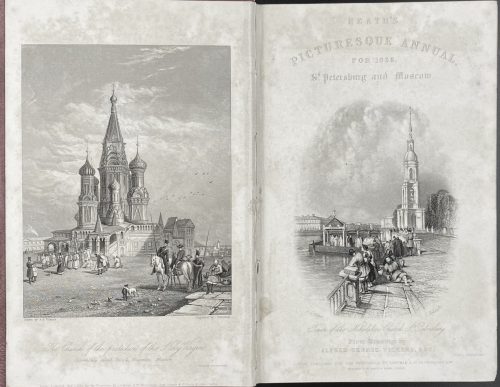 Engraved title: HEATH'S | PICTURESQUE ANNUAL, | FOR 1836. | St. Petersburg and Moscow. | {vignette Nikolskoi church signed: A.G. Vickers — E. Radclyffe} | Tower of the Nikolskoi church St. Petersburg | From Drawings by | ALFRED GEORGE VICKERS, ESQ. | Printed by Arnold & Fisher | LONDON, PUBLISHED FOR THE PROPRIETOR, BY LONGMAN & Co. PATERNOSTER ROW: | RITTNER & Co. PARIS: & ASHER, BERLIN. || Title page: A JOURNEY | TO ST. PETERSBURG AND MOSCOW | THROUGH COURLAND AND LIVONIA. | BY | LEITCH RITCHIE, Esq. | AUTHOR OF “TURNER’S ANNUAL TOUR”, “SCHINDERHANNES,” &c. | WITH TWENTY-FIVE SPLENDID ENGRAVINGS, | BY THE FIRST ARTISTS, AFTER DRAWINGS, | BY A.G. VICKERS, Esq. | LONDON: | LONGMAN, REES, BROWN, GREEN, AND LONGMAN. | PARIS: RITTNER AND GOUPILL. BERLIN: A. ASHER. | 1836. || Imprint: LONDON: | PRINTED BY J. HADDON AND CO., DOCTORS’ COMMONS. Pagination: [i-iii] iv [4] [1] 2-256, total 264 pages + 25 plates. Collation: 12mo; π4, B-Y6 Z2; total 132 leaves + frontispiece, engraved title and 23 leaves of steel-engraved plates w/tissue guards, extraneous to collation. Binding: full red morocco, blind-stamped boards, gilt-lettered spine, all edges gilt, 12mo, 20 x 13 cm. Note: Schinderhannes – real name Johannes Bückler (German, c.1778 – 1803): Leitch Ritchie. Schinderhannes: the Robber of the Rhine. (Library of Romance). — London: Smith, Elder, and Co., 1833. Contributors:
Engraved title: HEATH'S | PICTURESQUE ANNUAL, | FOR 1836. | St. Petersburg and Moscow. | {vignette Nikolskoi church signed: A.G. Vickers — E. Radclyffe} | Tower of the Nikolskoi church St. Petersburg | From Drawings by | ALFRED GEORGE VICKERS, ESQ. | Printed by Arnold & Fisher | LONDON, PUBLISHED FOR THE PROPRIETOR, BY LONGMAN & Co. PATERNOSTER ROW: | RITTNER & Co. PARIS: & ASHER, BERLIN. || Title page: A JOURNEY | TO ST. PETERSBURG AND MOSCOW | THROUGH COURLAND AND LIVONIA. | BY | LEITCH RITCHIE, Esq. | AUTHOR OF “TURNER’S ANNUAL TOUR”, “SCHINDERHANNES,” &c. | WITH TWENTY-FIVE SPLENDID ENGRAVINGS, | BY THE FIRST ARTISTS, AFTER DRAWINGS, | BY A.G. VICKERS, Esq. | LONDON: | LONGMAN, REES, BROWN, GREEN, AND LONGMAN. | PARIS: RITTNER AND GOUPILL. BERLIN: A. ASHER. | 1836. || Imprint: LONDON: | PRINTED BY J. HADDON AND CO., DOCTORS’ COMMONS. Pagination: [i-iii] iv [4] [1] 2-256, total 264 pages + 25 plates. Collation: 12mo; π4, B-Y6 Z2; total 132 leaves + frontispiece, engraved title and 23 leaves of steel-engraved plates w/tissue guards, extraneous to collation. Binding: full red morocco, blind-stamped boards, gilt-lettered spine, all edges gilt, 12mo, 20 x 13 cm. Note: Schinderhannes – real name Johannes Bückler (German, c.1778 – 1803): Leitch Ritchie. Schinderhannes: the Robber of the Rhine. (Library of Romance). — London: Smith, Elder, and Co., 1833. Contributors:Author: Leitch Ritchie (British, 1800 – 1865).
Illustrator: Alfred Gomersal Vickers (British, 1810 – 1837).
Publisher: Longman, Rees, Orme, Brown, Green and Longman (London).
Engravers: Turnbull, Thomas (British, fl. 1830s); Radclyffe, Edward (British, 1810 – 1863); Jorden, Henry (British, fl. 1829 – 1838); Fisher, Samuel (British, 1806 – 1851); Willmore, James Tibbits (British, 1800 – 1863); Higham, Thomas (British, 1795 – 1844); Appleton, J. W. (British, fl. 1834 – 1843); Wallis, Robert William (British, 1794 – 1878); Chevalier, William (British, 1804 – 1866); Kernot, James Harfield (British, 1802 – 1858); Lewis, James (British, 1782 – 1858); Carter, James (British, 1798 – 1855). Printer: John Haddon & Co. (London). Reference: Metropolitan Museum (NY); Royal Collection Trust (London). -
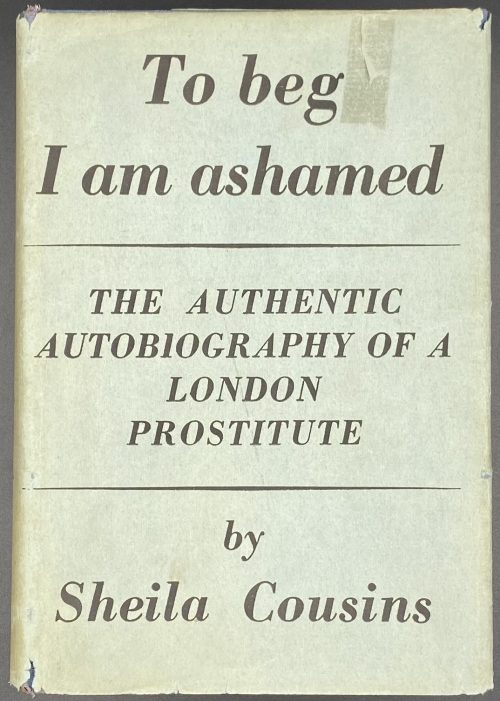 Title page: Sheila Cousins | TO BEG | I AM ASHAMED | THE VANGUARD PRESS • NEW YORK | 1938 || Pagination:[4] [1] 2-283 [284], total 288 pages. Collation: 8vo; [A]8 B-S8; total 144 leaves. Binding: Publisher’s blue buckram, black lettering to front cover and spine, price-clipped blue dust jacket, lettered front: To beg | I am ashamed |—| THE AUTHENTIC | AUTOBIOGRAPHY OF A | LONDON | PROSTITUTE |—| by | Sheila Cousins ||; fore-edge untrimmed. Size: 19.5 x 13.5 cm. Edition: 1st American edition Contributors: Graham Greene (British, 1904 – 1991) – author. Ronald Matthews (British, 1903 – 1967) – author. The Vanguard Press, NY (1926 – 1988) – publisher.
Title page: Sheila Cousins | TO BEG | I AM ASHAMED | THE VANGUARD PRESS • NEW YORK | 1938 || Pagination:[4] [1] 2-283 [284], total 288 pages. Collation: 8vo; [A]8 B-S8; total 144 leaves. Binding: Publisher’s blue buckram, black lettering to front cover and spine, price-clipped blue dust jacket, lettered front: To beg | I am ashamed |—| THE AUTHENTIC | AUTOBIOGRAPHY OF A | LONDON | PROSTITUTE |—| by | Sheila Cousins ||; fore-edge untrimmed. Size: 19.5 x 13.5 cm. Edition: 1st American edition Contributors: Graham Greene (British, 1904 – 1991) – author. Ronald Matthews (British, 1903 – 1967) – author. The Vanguard Press, NY (1926 – 1988) – publisher. -
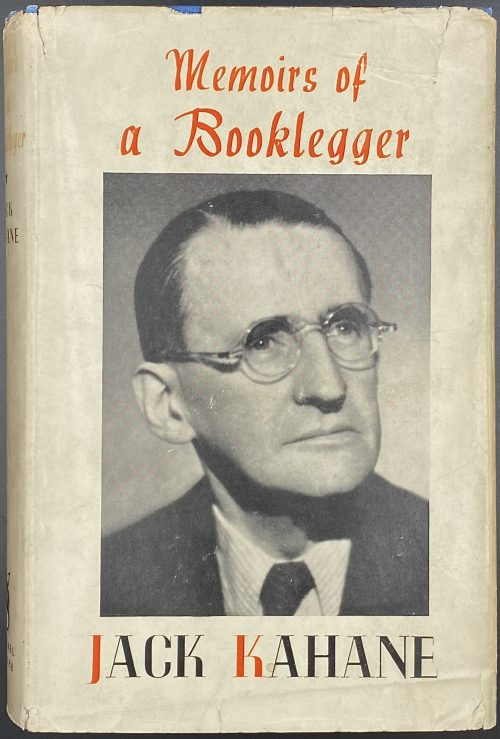 Title: JACK KAHANE | ★ | Memoirs of a | Booklegger | [space] | {publisher’s device} | MICHAEL JOSEPH LTD. | 26, Bloomsbury Street, London, W.C.I || Pagination: [1-6] 7-287 [288 blank]; total 288 pages. Collation: 8vo; [A]8 B-S8; total 144 leaves. Binding: 21.5 x 15 cm, by James Burn, publisher’s blue cloth, silver lettering to spine, yellow endpapers; cream dust-jacket with black and red lettering and reproduced photo portrait of the author. Contributors: Jack Kahane (British, 1887 – 1939) – author. Michael Joseph (British, 1897 – 1958); Michael Joseph Ltd. (London) – publisher. William Brendon & Son, Ltd.; Mayflower Press (Plymouth) – printer. John Dickinson & Co.; John Dickinson (British, 1782 – 1869) – paper maker. Frederick E. Kahane – dedicatee (brother of Jack).
Title: JACK KAHANE | ★ | Memoirs of a | Booklegger | [space] | {publisher’s device} | MICHAEL JOSEPH LTD. | 26, Bloomsbury Street, London, W.C.I || Pagination: [1-6] 7-287 [288 blank]; total 288 pages. Collation: 8vo; [A]8 B-S8; total 144 leaves. Binding: 21.5 x 15 cm, by James Burn, publisher’s blue cloth, silver lettering to spine, yellow endpapers; cream dust-jacket with black and red lettering and reproduced photo portrait of the author. Contributors: Jack Kahane (British, 1887 – 1939) – author. Michael Joseph (British, 1897 – 1958); Michael Joseph Ltd. (London) – publisher. William Brendon & Son, Ltd.; Mayflower Press (Plymouth) – printer. John Dickinson & Co.; John Dickinson (British, 1782 – 1869) – paper maker. Frederick E. Kahane – dedicatee (brother of Jack). -
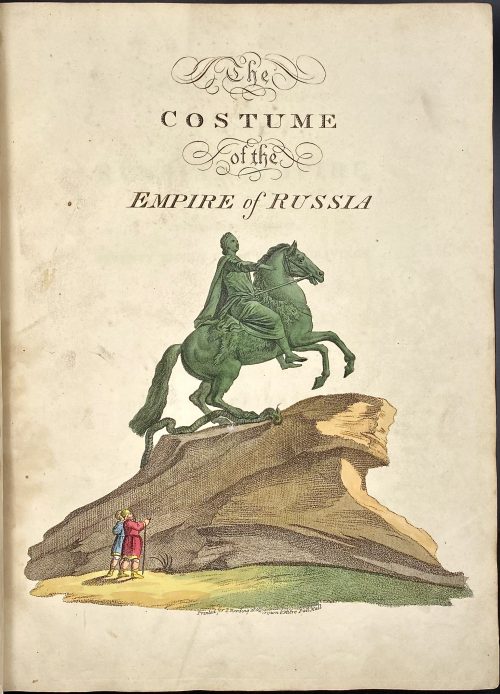 Engraved title: The | Costume | of the | Empire of Russia | {copper horseman vignette} | signed under: Printed for E. Harding at the Crown and Mitre Pall Mall || English title: COSTUME | OF THE | RUSSIAN EMPIRE, | ILLUSTRATED BY UPWARDS OF | SEVENTY RICHLY COLOURED ENGRAVINGS. | DEDICATED BY PERMISSION TO | HER ROYAL HIGHNESS | THE | PRINCESS ELIZABETH. | LONDON: | PRINTED BY T. BENSLEY, BOLT COURT, FLEET STREET; | FOR JOHN STOCKDALE, PICCADILLY. | 1811. || Paper: thick wove paper, the leaf with “Copper Horseman” watermarked J. Whatman 1808; the French title – Edmeads & Co 1809, E2 – E & P 1807, plates are not watermarked [NYPL: An “1803” copy of The Costumes of the Russian Empire has watermarks from 1796 (W Elgar), 1809 (Edmeads & Co), 1811, 1813 (J. Whatman), 1818, and 1829]. Collation: 4to; (1) engraved title by E. Harding (“Copper Horseman” monument of Peter the Great), (2) English title, (3) French title, (4) Dedication to her Royal Highness the Princess Elizabeth by E. Harding (1803), (5) Contents —> π5 a2 B-S4 T2, all second leaves in all quires but C and T signed “2”, 77 leaves total, unpaginated, plus 72 plates (34.5 x 25.5 cm), stipple and line engravings, hand-coloured, by John Dadley after William Alexander. Binding: 36 x 27 cm, straight-grain green morocco, blind-stamped palmette border withing gilt-stamped palmette border to boards, raised bands decorated in gilt, gilt in compartments, two brown morocco labels with gilt lettering, brown endpapers, 2 additional flyleaves at front and back, AEG. Authorship and artistic work are attributed to Alexander and Dadley, but not signed. 1st edition in 1803 was published by William Richard Beckford Miller (British, 1769 – 1844). Catalogue raisonné: Tooley (1906): p. 151. Contributors: William Alexander (British, 1767 – 1816) – artist, author. John Dadley (British, 1767 – 1817) – engraver. Thomas Bensley (British, 1759 – 1835) – printer. John Stockdale (British, 1750 – 1814) – publisher. Edward Harding (British, 1755 – 1840) – publisher of 1803 edition (author of dedication) Princess Elizabeth of the United Kingdom (British, 1770 – 1840) – dedicatee.
Engraved title: The | Costume | of the | Empire of Russia | {copper horseman vignette} | signed under: Printed for E. Harding at the Crown and Mitre Pall Mall || English title: COSTUME | OF THE | RUSSIAN EMPIRE, | ILLUSTRATED BY UPWARDS OF | SEVENTY RICHLY COLOURED ENGRAVINGS. | DEDICATED BY PERMISSION TO | HER ROYAL HIGHNESS | THE | PRINCESS ELIZABETH. | LONDON: | PRINTED BY T. BENSLEY, BOLT COURT, FLEET STREET; | FOR JOHN STOCKDALE, PICCADILLY. | 1811. || Paper: thick wove paper, the leaf with “Copper Horseman” watermarked J. Whatman 1808; the French title – Edmeads & Co 1809, E2 – E & P 1807, plates are not watermarked [NYPL: An “1803” copy of The Costumes of the Russian Empire has watermarks from 1796 (W Elgar), 1809 (Edmeads & Co), 1811, 1813 (J. Whatman), 1818, and 1829]. Collation: 4to; (1) engraved title by E. Harding (“Copper Horseman” monument of Peter the Great), (2) English title, (3) French title, (4) Dedication to her Royal Highness the Princess Elizabeth by E. Harding (1803), (5) Contents —> π5 a2 B-S4 T2, all second leaves in all quires but C and T signed “2”, 77 leaves total, unpaginated, plus 72 plates (34.5 x 25.5 cm), stipple and line engravings, hand-coloured, by John Dadley after William Alexander. Binding: 36 x 27 cm, straight-grain green morocco, blind-stamped palmette border withing gilt-stamped palmette border to boards, raised bands decorated in gilt, gilt in compartments, two brown morocco labels with gilt lettering, brown endpapers, 2 additional flyleaves at front and back, AEG. Authorship and artistic work are attributed to Alexander and Dadley, but not signed. 1st edition in 1803 was published by William Richard Beckford Miller (British, 1769 – 1844). Catalogue raisonné: Tooley (1906): p. 151. Contributors: William Alexander (British, 1767 – 1816) – artist, author. John Dadley (British, 1767 – 1817) – engraver. Thomas Bensley (British, 1759 – 1835) – printer. John Stockdale (British, 1750 – 1814) – publisher. Edward Harding (British, 1755 – 1840) – publisher of 1803 edition (author of dedication) Princess Elizabeth of the United Kingdom (British, 1770 – 1840) – dedicatee. -
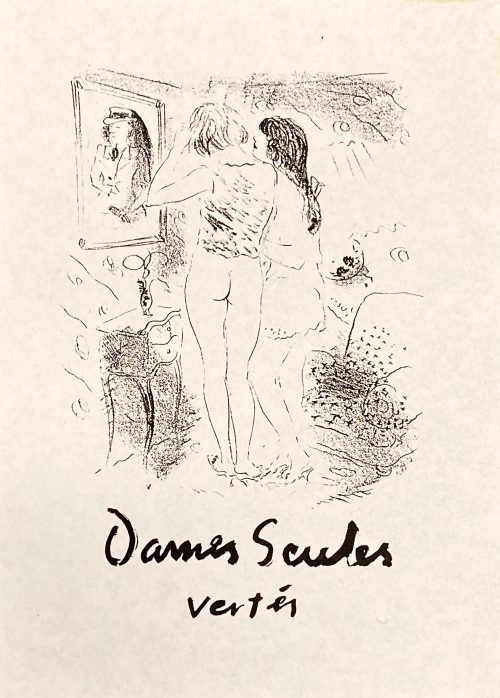 1st edition, limited to 52 copies of which 7 copies on Japon paper (№ 1-7) and 45 copies on Rives paper (№ 8-52); printed by Maurice Daratiere; this copy is № 50. “Ladies only” – a pictorial album, unbound, printed by Maurice Darantiere, with 15 black and white lithographs by Edouard Duchâtel (French, 19th-20th century) after drawings by Marcel Vertès on cream wove paper 38 x 28 cm; French flapped wrappers, with the lithographed manuscript title “Dames seules” in a grey clamshell box 40 x 30 cm; printed by Maurice Darantiere, title with vignette pasted to box cover, one image on a double sheet; all illustrations with tissue guards. Bookplate “From the Library of | Vance Gerry | The Weather Bird Press | pasted inside the box cover (see Vance Gerry and The Weather Bird Press). Provenance: Vance Bryden Gerry (American, 1929 – 2005) Contributors: Marcel Vertès [Marcell Vértes] (Jewish-Hungarian-French, 1895 – 1961) – artist. Francis Carco [François Carcopino-Tusoli] (French, 1886 – 1958) – author. Edouard Duchâtel (French, 19th-20th century) – artist, lithographer. Maurice Darantiere (French, 1882 – 1962) – printer. Louis Godefroy (French, 1885 – 1934) – publisher. Other names: Marcel Vertès, Marcel Vertes, Marcell Vértes
1st edition, limited to 52 copies of which 7 copies on Japon paper (№ 1-7) and 45 copies on Rives paper (№ 8-52); printed by Maurice Daratiere; this copy is № 50. “Ladies only” – a pictorial album, unbound, printed by Maurice Darantiere, with 15 black and white lithographs by Edouard Duchâtel (French, 19th-20th century) after drawings by Marcel Vertès on cream wove paper 38 x 28 cm; French flapped wrappers, with the lithographed manuscript title “Dames seules” in a grey clamshell box 40 x 30 cm; printed by Maurice Darantiere, title with vignette pasted to box cover, one image on a double sheet; all illustrations with tissue guards. Bookplate “From the Library of | Vance Gerry | The Weather Bird Press | pasted inside the box cover (see Vance Gerry and The Weather Bird Press). Provenance: Vance Bryden Gerry (American, 1929 – 2005) Contributors: Marcel Vertès [Marcell Vértes] (Jewish-Hungarian-French, 1895 – 1961) – artist. Francis Carco [François Carcopino-Tusoli] (French, 1886 – 1958) – author. Edouard Duchâtel (French, 19th-20th century) – artist, lithographer. Maurice Darantiere (French, 1882 – 1962) – printer. Louis Godefroy (French, 1885 – 1934) – publisher. Other names: Marcel Vertès, Marcel Vertes, Marcell Vértes -
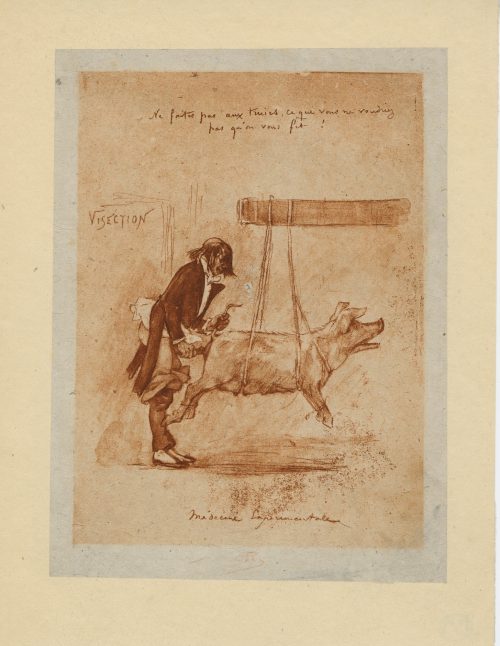
Sanguine print on toned China paper pasted on cream wove paper sheet, depicting a dressed-up man trying to copulate with a hanged sow. Inscription on top of the plate: "Ne faites pas aux truies ce que vous ne voudriez pas qu'on vous fit", and below: "Visection" (sic.). Owner's stamp 'LvM' on verso.
Dimensions: Paper: 26.8 x 20.6 cm; India paper: 21.5 x 16.2 cm; Image: 19.3 x 14.2 cm.
Catalogue raisonné: Arthur Hubschmid (1977): 661; Graphics irreverent and erotic (1968): 42.
-
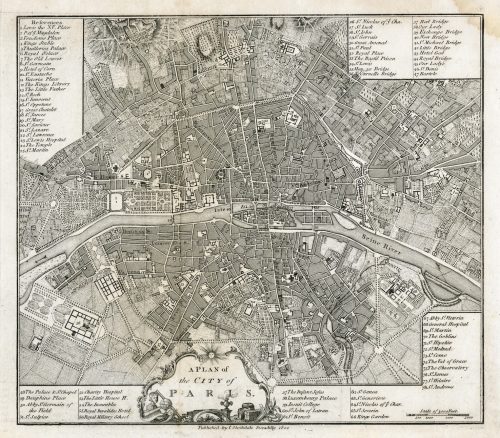 In pictorial frame: A PLAN of | the CITY of PARIS. || Under the border: Published by I. Stockdale Piccadilly 1800 || Dimensions: Sheet: 29 x 34.5 cm; Image: 22.7 x 25.9 cm.
In pictorial frame: A PLAN of | the CITY of PARIS. || Under the border: Published by I. Stockdale Piccadilly 1800 || Dimensions: Sheet: 29 x 34.5 cm; Image: 22.7 x 25.9 cm. -
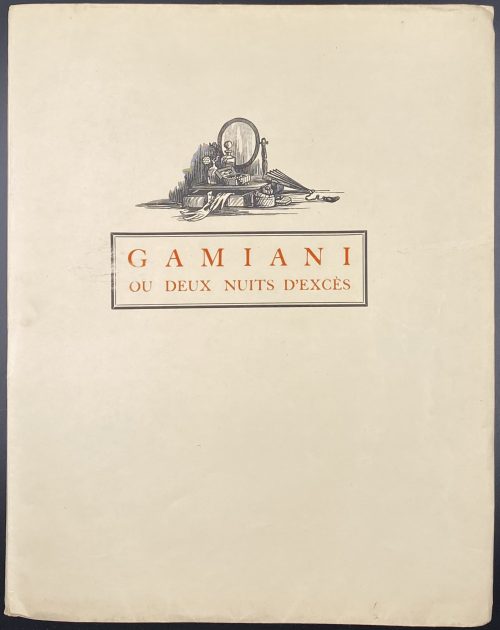 Description: Softcover volume 27 x 21.3 cm in publisher’s French flapped cream wrappers, with a vignette and lettered in red within a black frame to front "GAMIANI | OU DEUX NUITS D'EXCÈS". Printed on unmarked wove paper, outer and lower margins untrimmed. Illustrated with full-page frontispiece, 10 headpieces, and 5 smaller woodcuts (one repeated on the front wrapper and on t.p.) by Pierre Aubert after Jean-Gabriel Daragnès [pseud. Jean de Guethary], some with inlaid tissue guards. Copy enriched with one graphite pencil drawing signed "J. de Guethary", tipped in before h.t. Title-page (red and black): GAMIANI | OU DEUX NUITS D'EXCÈS | PAR A. DE M. | Avec | des vignettes | de | JEAN DE GUETHARY | {VIGNETTE} | — | CHEZ UN BOURGEOIS DE PARIS | Rue du Coq Hardi | 1845 || Pagination: [i-vi] (orig. drawing, h.t. / vignette, t.p./limit.) [vii] viii-xx, [1-3] 4-64 [4]; total 88 pages. Limitation: Edition limited to 110 copies. According to Dutel, 110 copies were printed on Japon ancient, 3 on Japon Impérial, and 3 on Whatman. This copy is № 115. Catalogue raisonné: Dutel (1920-1970): № 1630, p. 183; Pia (Enfer) 527, p. 286. Alfred de Musset (French, 1810 – 1857) – author. Jean-Gabriel Daragnès (French, 1886 – 1950) – artist, publisher. Pierre Aubert (Swiss, 1910 – 1987) – engraver.
Description: Softcover volume 27 x 21.3 cm in publisher’s French flapped cream wrappers, with a vignette and lettered in red within a black frame to front "GAMIANI | OU DEUX NUITS D'EXCÈS". Printed on unmarked wove paper, outer and lower margins untrimmed. Illustrated with full-page frontispiece, 10 headpieces, and 5 smaller woodcuts (one repeated on the front wrapper and on t.p.) by Pierre Aubert after Jean-Gabriel Daragnès [pseud. Jean de Guethary], some with inlaid tissue guards. Copy enriched with one graphite pencil drawing signed "J. de Guethary", tipped in before h.t. Title-page (red and black): GAMIANI | OU DEUX NUITS D'EXCÈS | PAR A. DE M. | Avec | des vignettes | de | JEAN DE GUETHARY | {VIGNETTE} | — | CHEZ UN BOURGEOIS DE PARIS | Rue du Coq Hardi | 1845 || Pagination: [i-vi] (orig. drawing, h.t. / vignette, t.p./limit.) [vii] viii-xx, [1-3] 4-64 [4]; total 88 pages. Limitation: Edition limited to 110 copies. According to Dutel, 110 copies were printed on Japon ancient, 3 on Japon Impérial, and 3 on Whatman. This copy is № 115. Catalogue raisonné: Dutel (1920-1970): № 1630, p. 183; Pia (Enfer) 527, p. 286. Alfred de Musset (French, 1810 – 1857) – author. Jean-Gabriel Daragnès (French, 1886 – 1950) – artist, publisher. Pierre Aubert (Swiss, 1910 – 1987) – engraver. -
 Title: Fourth lunar month [卯月] (Uzuki no zu); Series: Fashionable Twelve Months (Imayo juni-kagetsu). Another version of translation: Modern Beauties of Twelve Months. Artist: Utagawa Toyokuni I [歌川豊国] (1769–1825). Pubisher: Ibaya Senzaburō [伊場屋仙三郎] (Japanese, 1815 – 1869), seal: Dansendō [伊場仙]. Signed: Toyokuni ga and sealed with toshidama. Date-kiwame seal: Ushi (ox), Bunsei 5 (1822). Size: double-sheet uncut fan print ( aiban uchiwa-e), 219 x 295 mm.
Title: Fourth lunar month [卯月] (Uzuki no zu); Series: Fashionable Twelve Months (Imayo juni-kagetsu). Another version of translation: Modern Beauties of Twelve Months. Artist: Utagawa Toyokuni I [歌川豊国] (1769–1825). Pubisher: Ibaya Senzaburō [伊場屋仙三郎] (Japanese, 1815 – 1869), seal: Dansendō [伊場仙]. Signed: Toyokuni ga and sealed with toshidama. Date-kiwame seal: Ushi (ox), Bunsei 5 (1822). Size: double-sheet uncut fan print ( aiban uchiwa-e), 219 x 295 mm.

-
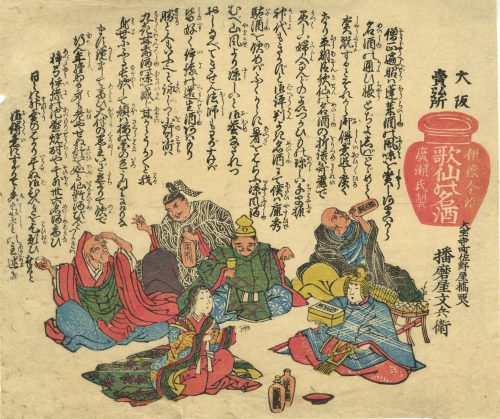 An uncut fan print uchiwa-e, size 22.7 x 28.7cm, by an unknown artist.
An uncut fan print uchiwa-e, size 22.7 x 28.7cm, by an unknown artist. -
 Artist: Utagawa Kunisada [歌川 国貞] a.k.a. Utagawa Toyokuni III [三代歌川豊国] (Japanese, 1786 – 1865). Signed: Kunisada ga [国貞画] in a red double-gourd cartouche. Publisher: Iseya Sōemon [伊勢屋惣右衛門] (Japanese, c. 1776 – 1862). Date seal and kiwame censor seal: 1840 (Tenpō 11). Media: Untrimmed fan print (uchiwa-e), 227 x 293 mm. Title: Benzaiten Shrine at Honjō Block One [ひとつ目乃弁天] (Hitotsume no Benten). Provenance: The Collection of Paul F. Walter, Christie's, New York, 2017, lot 341; sold together with 5 other fan prints for $25,000. Before: Christie's, New York, 1997, lot 93 ($5,520). Ref: [LIB-1693.2018] The Collection of Paul Walter. — NY: Christie's, 2017, p. 363. Ref: Israel Goldman, Catalogue 2018, № 31: "Utagawa Kunisada (1786-1865) A Woman Reading a Letter by the Light of a Lantern. Hitotsume no Benten (One-eyed Benten). 1840. Fan print. Provenance: Japanese Prints, Paintings and Screens, Christie's, New York, 1997, lot 93 ($5,520), The Collection of Paul F. Walter, Christie's, New York, 2017, lot 341. Fine impression and colour. Expertly restored wormholes in the lower margin." Markus Sesko comment regarding the series title: "Some time between in the latter half of the 17th century, blind acupuncturist Sugiyama Waichi (1614–1694) cured a neurotic disease afflicting Shōgun Tokugawa Tsunayoshi. Tsunayoshi asked Sugiyama what he would like as a reward, he answered that all that he would really desire was just one functioning eye. Now here we arrive at a wordplay. “One eye,” as you know, is Hitotsu-me in Japanese. As Tsunayoshi obviously could not reward Sugiyama with an eye, he gave him the entire first block of the Honjō neighbourhood in Edo, measuring about 1.2 ha. So, Honjō Block One is Honjō Hitotsu-me in Japanese as me not only means “eye,” but also “number.” Sugiyama moved there, but as he was praying to Benzaiten enshrined in the Enoshima-jinja southwest of Kamakura, Tsunayoshi gave Sugiyama permission to erect a small shrine on his new premises that was then dedicated to Benzaiten as well. To spare the old blind man the long trip so to speak. This shrine was named Honjō Hitotsu-me Benzaiten Shrine, short Hitotsu-me Benten, meaning the “Benzaiten Shrine at Honjō Block One.” That is, the label in the print refers to this context, i.e., location, not to a one-eyed Benzaiten. Sugiyama also had some rock formations of the “original” Benzaiten Shrine at Enoshima copied at his place, which was named Iwaya (い王や) (see picture attached). The lantern the woman is holding in the print is inscribed “Imuya” (い無や). Usually, the character mu (無) is not read wa in replacing a syllable, so maybe Imuya can be attributed to artistic freedom on part of Utagawa Kunisada, referring to the local Iwaya garden?"
Artist: Utagawa Kunisada [歌川 国貞] a.k.a. Utagawa Toyokuni III [三代歌川豊国] (Japanese, 1786 – 1865). Signed: Kunisada ga [国貞画] in a red double-gourd cartouche. Publisher: Iseya Sōemon [伊勢屋惣右衛門] (Japanese, c. 1776 – 1862). Date seal and kiwame censor seal: 1840 (Tenpō 11). Media: Untrimmed fan print (uchiwa-e), 227 x 293 mm. Title: Benzaiten Shrine at Honjō Block One [ひとつ目乃弁天] (Hitotsume no Benten). Provenance: The Collection of Paul F. Walter, Christie's, New York, 2017, lot 341; sold together with 5 other fan prints for $25,000. Before: Christie's, New York, 1997, lot 93 ($5,520). Ref: [LIB-1693.2018] The Collection of Paul Walter. — NY: Christie's, 2017, p. 363. Ref: Israel Goldman, Catalogue 2018, № 31: "Utagawa Kunisada (1786-1865) A Woman Reading a Letter by the Light of a Lantern. Hitotsume no Benten (One-eyed Benten). 1840. Fan print. Provenance: Japanese Prints, Paintings and Screens, Christie's, New York, 1997, lot 93 ($5,520), The Collection of Paul F. Walter, Christie's, New York, 2017, lot 341. Fine impression and colour. Expertly restored wormholes in the lower margin." Markus Sesko comment regarding the series title: "Some time between in the latter half of the 17th century, blind acupuncturist Sugiyama Waichi (1614–1694) cured a neurotic disease afflicting Shōgun Tokugawa Tsunayoshi. Tsunayoshi asked Sugiyama what he would like as a reward, he answered that all that he would really desire was just one functioning eye. Now here we arrive at a wordplay. “One eye,” as you know, is Hitotsu-me in Japanese. As Tsunayoshi obviously could not reward Sugiyama with an eye, he gave him the entire first block of the Honjō neighbourhood in Edo, measuring about 1.2 ha. So, Honjō Block One is Honjō Hitotsu-me in Japanese as me not only means “eye,” but also “number.” Sugiyama moved there, but as he was praying to Benzaiten enshrined in the Enoshima-jinja southwest of Kamakura, Tsunayoshi gave Sugiyama permission to erect a small shrine on his new premises that was then dedicated to Benzaiten as well. To spare the old blind man the long trip so to speak. This shrine was named Honjō Hitotsu-me Benzaiten Shrine, short Hitotsu-me Benten, meaning the “Benzaiten Shrine at Honjō Block One.” That is, the label in the print refers to this context, i.e., location, not to a one-eyed Benzaiten. Sugiyama also had some rock formations of the “original” Benzaiten Shrine at Enoshima copied at his place, which was named Iwaya (い王や) (see picture attached). The lantern the woman is holding in the print is inscribed “Imuya” (い無や). Usually, the character mu (無) is not read wa in replacing a syllable, so maybe Imuya can be attributed to artistic freedom on part of Utagawa Kunisada, referring to the local Iwaya garden?" -
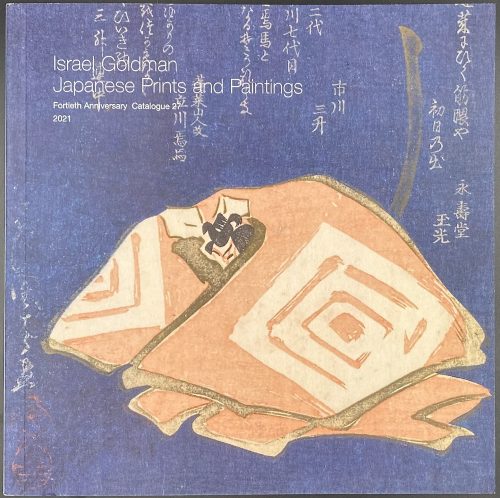 Softcover, pictorial wrappers, square 21 x 21 cm, 46 leaves, unpaginated, with illustrations in colour, 88 entries, with price list laid in. Contributor: Israel Goldman In this collection:
Softcover, pictorial wrappers, square 21 x 21 cm, 46 leaves, unpaginated, with illustrations in colour, 88 entries, with price list laid in. Contributor: Israel Goldman In this collection: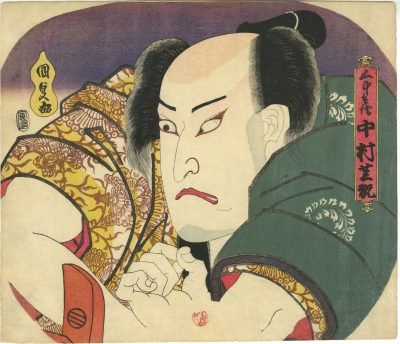
SVJP-0349.2021: Utagawa Kunisada. Kabuki actor Nakamura Shikan II as Gotobei / Fan print, 1830.
-
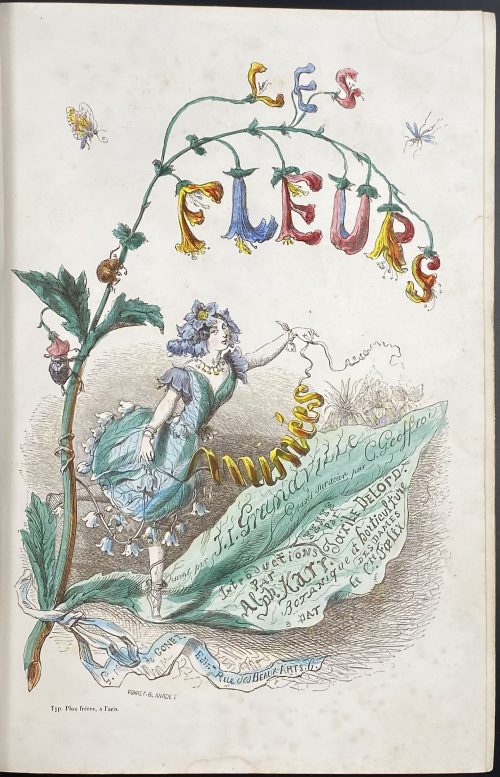 Description: Two parts in one volume, collated 4to, 26.3 x 18 cm, bound in quarter green pebbled morocco over green percaline panelled boards, spine with raised bands, gilt in compartments, lettered in gilt, signed in the bottom “L. Curmer”; marbled endpapers, all edges gilt. Part 1 is illustrated with a hand-coloured wood-engraved title-page by Porret and Blanadet and 28 hand-coloured steel engravings by Charles Geoffroy after J.-J. Grandville; part 2 is illustrated with a hand-coloured wood-engraved title-page by Quichon and 22 steel engravings by Charles Geoffroy after J.-J. Grandville, and two uncoloured botanical plates, unsigned. Title-page: LES | FLEURS ANIMÉES | PAR | J.-J. GRANDVILLE | INTRODUCTIONS | Par ALPH. KARR | TEXTE | Par TAXILE DELORD | — | PREMIÈRE (DEUXIÈME) PARTIE | — | PARIS | GABRIEL DE GONET, ÉDITEUR | 6, RUE DES BEAUX-ARTS, 6 || Collation: part 1: blank, [1] h.t./imprint (PARIS WALDER), hand-coloured engraved t.p., [1] t.p./blank, 1-324, [1] contents/blank, 28 hand-coloured plates; part 2: [1] h.t./imprint (PARIS WALDER), hand-coloured engraved t.p., [1] t.p./blank, [2] intro., [1]-294, 302, blank, 22 hand-coloured plates and 2 uncoloured plates. Pagination: part 1: [1-5] 6-260 [2] (total 262 pages), ils; part 2: [4] [i] ii-iv [1] 2-102, [2] [i] ii-iv, [105] 106-234 [2] (total 248 pages), ils. Coloured steel-engraved plates: Part 1: Bleuet et Coquelicot. Lis. Pensée. Tabac. Tulipe. Rose. Narcisse. Violette. Nenuphar. Laurier. Myrte. Marguerite. Camelia. Immortelle. Chèvre-feuille. Belle-de-nuit. Oeillet. Ciguë. Soleil. Fleur de grenadier. Lin. Eglantine. Pavot. Chardon. Fleur d'oranger. Capucine. Guimauve. Primevère – Perce-neige. Part 2: Pois de senteur. Cactus. Dahlia. Sensitive. Fleur de pêcher. Aubépine. Vigne. Myosotis. Jasmin. Scabieuse & Souci. Traite des fleurs. Flèche-d'eau. Hortensia, couronne impériale. Verveine. Giroflée. Thé et Café. Lilas. Tubéreuse Jonquille. Bal. Retour des fleurs. Erratum. Pervenche desséchée. Plates signed "Grandville del. – Ch. Geoffroy sc. – G. de Gonet, editeur" but some signed "Imp. Delamain et Sarazin rue Git le Cœur 8 Paris." Plates accompanied by tissue guards. Gordon N. Ray: "Most of the plates show an elegant lady in a garden, her dress covered with an extraordinary pattern of flowers. She is sometimes accompanied by respectful creatures, animals and insects, even fish and reptiles". Edition: 2nd edition of 1847, each part has separate pagination; imprint: "Paris. — Typographie Walder, rue Bonaparte, 44". Second "tirage", the volumes being paged separately; the first "tirage", issued also in 1847, is paged continuously. Point of issue: Table des Matières has "Imprimerte Walder." Originally appeared in 83 separate parts in pictorial yellow wrappers. Contributors: J.-J. Grandville [Gèrard, Isidore-Adolphe] (French, 1803 – 1847) – artist. Taxile Delord (French, 1815 – 1877) – author. Comte Foelix [Louis-François Raban] (French, 1795 – 1870) – author. Jean-Baptiste Alphonse Karr (French, 1808 – 1890) – author. Charles Michel Geoffroy (French, 1819 – 1882) – engraver (on steel). Gabriel de Gonet (French, fl. 1847 – 1862) – publisher. Typographie Walder (Paris) – printer. Plon Freres (Paris) – printer. Delamain et Sarrazin (Paris) – printer. Henri Désiré Porret (French, 1800 – 1867) – engraver (on wood). Jules Blanadet (French, 1824 – ?) – engraver (on wood). Quichon (French, fl. c. 1850s) – engraver (on wood). Catalogue raisonné: L. Carteret (Le trésor): p. 286; Ray (French): 198, pp. 278-9; Vicaire (Manuel): D III, p. 133-4; Brivois (Guide): pp. 147-150. In collections: MET 1970.565.423.1–.2; Vanderbilt University; V&A L.755-1943. Provenance: Léon Curmer (French, ).
Description: Two parts in one volume, collated 4to, 26.3 x 18 cm, bound in quarter green pebbled morocco over green percaline panelled boards, spine with raised bands, gilt in compartments, lettered in gilt, signed in the bottom “L. Curmer”; marbled endpapers, all edges gilt. Part 1 is illustrated with a hand-coloured wood-engraved title-page by Porret and Blanadet and 28 hand-coloured steel engravings by Charles Geoffroy after J.-J. Grandville; part 2 is illustrated with a hand-coloured wood-engraved title-page by Quichon and 22 steel engravings by Charles Geoffroy after J.-J. Grandville, and two uncoloured botanical plates, unsigned. Title-page: LES | FLEURS ANIMÉES | PAR | J.-J. GRANDVILLE | INTRODUCTIONS | Par ALPH. KARR | TEXTE | Par TAXILE DELORD | — | PREMIÈRE (DEUXIÈME) PARTIE | — | PARIS | GABRIEL DE GONET, ÉDITEUR | 6, RUE DES BEAUX-ARTS, 6 || Collation: part 1: blank, [1] h.t./imprint (PARIS WALDER), hand-coloured engraved t.p., [1] t.p./blank, 1-324, [1] contents/blank, 28 hand-coloured plates; part 2: [1] h.t./imprint (PARIS WALDER), hand-coloured engraved t.p., [1] t.p./blank, [2] intro., [1]-294, 302, blank, 22 hand-coloured plates and 2 uncoloured plates. Pagination: part 1: [1-5] 6-260 [2] (total 262 pages), ils; part 2: [4] [i] ii-iv [1] 2-102, [2] [i] ii-iv, [105] 106-234 [2] (total 248 pages), ils. Coloured steel-engraved plates: Part 1: Bleuet et Coquelicot. Lis. Pensée. Tabac. Tulipe. Rose. Narcisse. Violette. Nenuphar. Laurier. Myrte. Marguerite. Camelia. Immortelle. Chèvre-feuille. Belle-de-nuit. Oeillet. Ciguë. Soleil. Fleur de grenadier. Lin. Eglantine. Pavot. Chardon. Fleur d'oranger. Capucine. Guimauve. Primevère – Perce-neige. Part 2: Pois de senteur. Cactus. Dahlia. Sensitive. Fleur de pêcher. Aubépine. Vigne. Myosotis. Jasmin. Scabieuse & Souci. Traite des fleurs. Flèche-d'eau. Hortensia, couronne impériale. Verveine. Giroflée. Thé et Café. Lilas. Tubéreuse Jonquille. Bal. Retour des fleurs. Erratum. Pervenche desséchée. Plates signed "Grandville del. – Ch. Geoffroy sc. – G. de Gonet, editeur" but some signed "Imp. Delamain et Sarazin rue Git le Cœur 8 Paris." Plates accompanied by tissue guards. Gordon N. Ray: "Most of the plates show an elegant lady in a garden, her dress covered with an extraordinary pattern of flowers. She is sometimes accompanied by respectful creatures, animals and insects, even fish and reptiles". Edition: 2nd edition of 1847, each part has separate pagination; imprint: "Paris. — Typographie Walder, rue Bonaparte, 44". Second "tirage", the volumes being paged separately; the first "tirage", issued also in 1847, is paged continuously. Point of issue: Table des Matières has "Imprimerte Walder." Originally appeared in 83 separate parts in pictorial yellow wrappers. Contributors: J.-J. Grandville [Gèrard, Isidore-Adolphe] (French, 1803 – 1847) – artist. Taxile Delord (French, 1815 – 1877) – author. Comte Foelix [Louis-François Raban] (French, 1795 – 1870) – author. Jean-Baptiste Alphonse Karr (French, 1808 – 1890) – author. Charles Michel Geoffroy (French, 1819 – 1882) – engraver (on steel). Gabriel de Gonet (French, fl. 1847 – 1862) – publisher. Typographie Walder (Paris) – printer. Plon Freres (Paris) – printer. Delamain et Sarrazin (Paris) – printer. Henri Désiré Porret (French, 1800 – 1867) – engraver (on wood). Jules Blanadet (French, 1824 – ?) – engraver (on wood). Quichon (French, fl. c. 1850s) – engraver (on wood). Catalogue raisonné: L. Carteret (Le trésor): p. 286; Ray (French): 198, pp. 278-9; Vicaire (Manuel): D III, p. 133-4; Brivois (Guide): pp. 147-150. In collections: MET 1970.565.423.1–.2; Vanderbilt University; V&A L.755-1943. Provenance: Léon Curmer (French, ). -
 Artist: Utagawa Hiroshige II (二代目 歌川広重] (Japanese, 1826 – 1869). Signed: Hiroshige ga. Publisher: Iseya Sōemon [伊勢屋惣右衛門] (Japanese, c. 1776 – 1862); seal: Hanmoto, Ue [板元 上] (Marks 19-047 | 156d). Combined date seal and kiwame censor seal: Bunkyū 2 (1862) Media: Fan print (uchiwa-e, 団扇絵), 230 x 296 mm.
Artist: Utagawa Hiroshige II (二代目 歌川広重] (Japanese, 1826 – 1869). Signed: Hiroshige ga. Publisher: Iseya Sōemon [伊勢屋惣右衛門] (Japanese, c. 1776 – 1862); seal: Hanmoto, Ue [板元 上] (Marks 19-047 | 156d). Combined date seal and kiwame censor seal: Bunkyū 2 (1862) Media: Fan print (uchiwa-e, 団扇絵), 230 x 296 mm. -
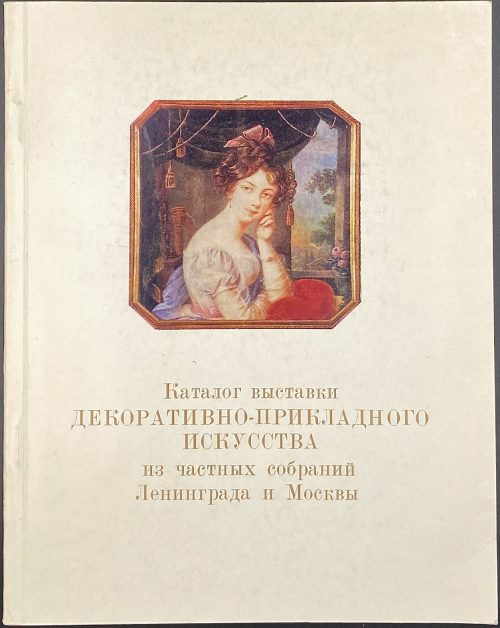 Softcover, 21.5 x 17 cm, glossy pictorial wrappers, pp.: [2] 3-[52] [53-88] 89-90 [2]; total 92 pages, incl. 18 leaves of plates within collation, not paginated.
Softcover, 21.5 x 17 cm, glossy pictorial wrappers, pp.: [2] 3-[52] [53-88] 89-90 [2]; total 92 pages, incl. 18 leaves of plates within collation, not paginated. -
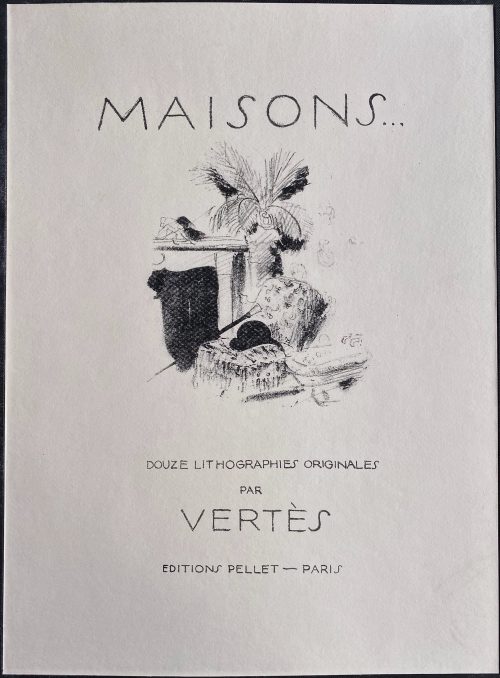 Album in-folio of 13 lithographs by Marcel Vertès, incl. title-page, each in a passe-partout 41.5 x 31.7 cm with 33.0 x 23.0 cm window, printed on wove paper sheets 38.0 x 28.0 cm and crayon-coloured by the artist; graphite pencil drawings by Marcel Vertès on the lower-right corner of each passe-partout; all in a buckram-backed flapped folder, signed ‘AT BOICHOT’, with an uncoloured title-page lithograph on front cover. Edition limited to 100 copies on Chine (№№ 1-100) and 900 on Vélin (№№ 1 to 900); this is a copy № 22 (Vélin), unique as enhanced by the artist. Double-folio leaf 41 x 31 cm with text by Pierre Mac-Orlan. These lithographs, uncoloured, were used in Pierre Mac-Orlan. Les jeux du demi-jour / avec douze lithographies de Vertès. — Paris: Les arts et le livre, 1926 [LIB-2893.2021]. Lithographed title-page: MAISONS.... | {vignette} | DOUZE LITHOGRAPHIES ORIGINALES | PAR | VERTÈS | ÉDITIONS PELLET ~ PARIS || Catalogue raisonné: Vokaer: № 5, p. 7; Nordmann (1): 423, p. 267. Contributors: Pierre Mac-Orlan (French, 1882 – 1970) – author. Marcel Vertès [Marcell Vértes] (Jewish-Hungarian-French, 1895 – 1961) – artist. Gustave Pellet (1859 – 1919) – publisher. Thomas Boichot – bookbinder. Description by J.-P. Dutel: MAC ORLAN Pierre. VERTES Marcel. MAISONS... Douze lithographies originales. Paris, Editions Pellet, [1925]. In-folio (410 x 310 mm) de [4] ff. et 13 lithographies sous passe-partout dont un titre. Chemise en demi-soienoire, premier plat illustré de la même lithographie que celle utilisée pour le titre (AT Boichot). TIRAGE : 100 albums sur chine avant la signature gravée, chaque planche signée. 900 albums sur vélin. :Un des 900 albums sur vélin (n° 22). EXEMPLAIRE UNIQUE DANS LEQUEL LES 13 LITHOGRAPHIES ONT ÉTÉCOLORIÉES AUX CRAYONS DE COULEURS PAR VERTÈS. DE PLUS, CHAQUE PASSE-PARTOUT COMPORTE EN BAS À DROITE UN CROQUIS ORIGINAL À LA MINE DE PLOMB CORRESPONDANT À UNE VERSION PLUS LIBRE DELA LITHO.
Album in-folio of 13 lithographs by Marcel Vertès, incl. title-page, each in a passe-partout 41.5 x 31.7 cm with 33.0 x 23.0 cm window, printed on wove paper sheets 38.0 x 28.0 cm and crayon-coloured by the artist; graphite pencil drawings by Marcel Vertès on the lower-right corner of each passe-partout; all in a buckram-backed flapped folder, signed ‘AT BOICHOT’, with an uncoloured title-page lithograph on front cover. Edition limited to 100 copies on Chine (№№ 1-100) and 900 on Vélin (№№ 1 to 900); this is a copy № 22 (Vélin), unique as enhanced by the artist. Double-folio leaf 41 x 31 cm with text by Pierre Mac-Orlan. These lithographs, uncoloured, were used in Pierre Mac-Orlan. Les jeux du demi-jour / avec douze lithographies de Vertès. — Paris: Les arts et le livre, 1926 [LIB-2893.2021]. Lithographed title-page: MAISONS.... | {vignette} | DOUZE LITHOGRAPHIES ORIGINALES | PAR | VERTÈS | ÉDITIONS PELLET ~ PARIS || Catalogue raisonné: Vokaer: № 5, p. 7; Nordmann (1): 423, p. 267. Contributors: Pierre Mac-Orlan (French, 1882 – 1970) – author. Marcel Vertès [Marcell Vértes] (Jewish-Hungarian-French, 1895 – 1961) – artist. Gustave Pellet (1859 – 1919) – publisher. Thomas Boichot – bookbinder. Description by J.-P. Dutel: MAC ORLAN Pierre. VERTES Marcel. MAISONS... Douze lithographies originales. Paris, Editions Pellet, [1925]. In-folio (410 x 310 mm) de [4] ff. et 13 lithographies sous passe-partout dont un titre. Chemise en demi-soienoire, premier plat illustré de la même lithographie que celle utilisée pour le titre (AT Boichot). TIRAGE : 100 albums sur chine avant la signature gravée, chaque planche signée. 900 albums sur vélin. :Un des 900 albums sur vélin (n° 22). EXEMPLAIRE UNIQUE DANS LEQUEL LES 13 LITHOGRAPHIES ONT ÉTÉCOLORIÉES AUX CRAYONS DE COULEURS PAR VERTÈS. DE PLUS, CHAQUE PASSE-PARTOUT COMPORTE EN BAS À DROITE UN CROQUIS ORIGINAL À LA MINE DE PLOMB CORRESPONDANT À UNE VERSION PLUS LIBRE DELA LITHO. -
 Artist: Utagawa Kunisada [歌川 国貞] a.k.a. Utagawa Toyokuni III [三代歌川豊国] (Japanese, 1786 – 1865). Artist signature: By the brush of the 79-year-old Toyokuni [七十九歳豊國画] (Nanajūkyū-sai Toyokuni ga). Publisher: Ebiya Rinnosuke [海老屋林之助] (Japanese, fl. c. 1832 – 1895); seal: ト/ 海老林 (to, Ebirin). Block carver: Matsushima Masakichi [松島政吉]; seal: carved by Masa [彫政] (Hori Masa). Combined date seal and kiwame censor seal: [子極] 1864 (Bunkyū 4/Genji 1). Media: Untrimmed fan print (uchiwa-e), 223 x 297 mm. Inscription in the cartouches: (R) Wakana-hime [若菜姫], Sawamura Tanosuke III [沢村田之助]; (L) Ashikaga Sanshichirō [足利三七郎], Sawamura Tosshō II [沢村訥升]. Play: Kinoene Soga Daikoku-bashira [甲子曽我大国柱], performed at the Morita theatre [森田座・守田座] (Morita-za) in 1864 (Bunkyū 4/Genji 1), 2nd month (see playbill at MFA-Boston Collection). Playwright: Muraoka Kōji II [村岡幸治]. Actors and Characters: Sawamura Tanosuke III [三代目沢村田之助] (Japanese, 1859 – 1878); other names: Shozan [曙山] (poetry name), Sawamura Yoshijirō I [初代沢村由次郎], here in the role of Princess Wakana [若菜姫] (Wakana-hime) (R). The story about Princess Wakana, Shiranui Monogatari, was written by Ryukatei Tanekazu [柳下亭種員] (Japanese, 1807 – 1858) and published as a 90-volume book of comics between 1849 and 1855. ...The tale revolves around the clash between the Kikuchi and Ōtomo clans. Princess Wakana’s father Ōtomo Sōrin [大友 宗麟] (1530 – 1587) was killed in a battle, and his spirit demanded revenge. To appease her late father's spirit, Princes Wakana acquired the power of the Earth Spider. She often appears in prints with a magic scroll, which helps her fight various enemies. Sawamura Tosshō II [二代目沢村訥升] (Japanese, 1854 – 1879); other names: Kōga [高賀] (poetry name), Sawamura Genpei II [二代目沢村源平], Sawamura Sōjūrō [澤村宗十郎], Suketakaya Takasuke IV [四代目助高屋高助], Sawamura Tosshi VI [六代目澤村訥子] (poetry name), here in the role of Ashikaga Sanshichirō [足利三七郎] (L) with a horse. According to Markus Sesko, the scene comes from the kabuki play Umakiri (馬斬り) by Tatsuoka Mansaku [辰岡万作] (17432 – 1809), which premiered in 1794. It was later assimilated into the Kabuki play Kozotte Mimasu Kuruwa no Datezome [襷廓三升伊達染], which was staged in the 1st lunar month of 1853 at the Nakamura-za. Umakiri is based on a Kyōgen play featured in Hideyoshi’s biography Taikōki [太閤記]. Its plot is that Ashikaga Sanchichirō Yoshitaka [足利三七郎義孝・義高], who is supposed to allude to Nobunaga’s son Oda Sanshichirō Nobutaka [織田三七郎信孝], attacks and kills a horse that is carrying 3,000 ryō (金三千両), money Mashiba Hisayoshi [真柴久吉] (an allusion to Hashiba Hideyoshi [羽柴秀吉]) had sent to be donated to a shrine on Mt. Kōya. The surrounding people try to catch him, but when they hear it is Yoshitaka who killed the horse, they fall to the ground and prostrate, and Yoshitaka leisurely leaves with the money. The plot is very simple, but Yoshitaka’s dashing appearance makes it very pleasing to watch. There are also prints that quote the main protagonist as Ashikaga Sanshichirō Harutaka [足利三七郎春高], and there is another title for the play, Sanzen-Ryō Kogane no Kurairi [三千両黄金蔵入] (Pocketing 3,000 ryō of gold). For reference, see also the BLOG. What these two characters are doing in one play remains a riddle. As Mr Graebner comments: "Most kabuki plays were only performed for one season (two months), and the books were lost. The playwrights have repeatedly used parts of plots from other plays, they have adopted characters, sometimes with the same or similar names. What can be found is the Kabuki Playbill (Tsuji banzuke) with cast and roles; the content is lost". Acknowledgements: Special thanks to Horst Graebner of the Kunisada Project and to Markus Sesko of The Metropolitan Museum, NY, for the analysis of the image and their invaluable contribution. For reference, see also:
Artist: Utagawa Kunisada [歌川 国貞] a.k.a. Utagawa Toyokuni III [三代歌川豊国] (Japanese, 1786 – 1865). Artist signature: By the brush of the 79-year-old Toyokuni [七十九歳豊國画] (Nanajūkyū-sai Toyokuni ga). Publisher: Ebiya Rinnosuke [海老屋林之助] (Japanese, fl. c. 1832 – 1895); seal: ト/ 海老林 (to, Ebirin). Block carver: Matsushima Masakichi [松島政吉]; seal: carved by Masa [彫政] (Hori Masa). Combined date seal and kiwame censor seal: [子極] 1864 (Bunkyū 4/Genji 1). Media: Untrimmed fan print (uchiwa-e), 223 x 297 mm. Inscription in the cartouches: (R) Wakana-hime [若菜姫], Sawamura Tanosuke III [沢村田之助]; (L) Ashikaga Sanshichirō [足利三七郎], Sawamura Tosshō II [沢村訥升]. Play: Kinoene Soga Daikoku-bashira [甲子曽我大国柱], performed at the Morita theatre [森田座・守田座] (Morita-za) in 1864 (Bunkyū 4/Genji 1), 2nd month (see playbill at MFA-Boston Collection). Playwright: Muraoka Kōji II [村岡幸治]. Actors and Characters: Sawamura Tanosuke III [三代目沢村田之助] (Japanese, 1859 – 1878); other names: Shozan [曙山] (poetry name), Sawamura Yoshijirō I [初代沢村由次郎], here in the role of Princess Wakana [若菜姫] (Wakana-hime) (R). The story about Princess Wakana, Shiranui Monogatari, was written by Ryukatei Tanekazu [柳下亭種員] (Japanese, 1807 – 1858) and published as a 90-volume book of comics between 1849 and 1855. ...The tale revolves around the clash between the Kikuchi and Ōtomo clans. Princess Wakana’s father Ōtomo Sōrin [大友 宗麟] (1530 – 1587) was killed in a battle, and his spirit demanded revenge. To appease her late father's spirit, Princes Wakana acquired the power of the Earth Spider. She often appears in prints with a magic scroll, which helps her fight various enemies. Sawamura Tosshō II [二代目沢村訥升] (Japanese, 1854 – 1879); other names: Kōga [高賀] (poetry name), Sawamura Genpei II [二代目沢村源平], Sawamura Sōjūrō [澤村宗十郎], Suketakaya Takasuke IV [四代目助高屋高助], Sawamura Tosshi VI [六代目澤村訥子] (poetry name), here in the role of Ashikaga Sanshichirō [足利三七郎] (L) with a horse. According to Markus Sesko, the scene comes from the kabuki play Umakiri (馬斬り) by Tatsuoka Mansaku [辰岡万作] (17432 – 1809), which premiered in 1794. It was later assimilated into the Kabuki play Kozotte Mimasu Kuruwa no Datezome [襷廓三升伊達染], which was staged in the 1st lunar month of 1853 at the Nakamura-za. Umakiri is based on a Kyōgen play featured in Hideyoshi’s biography Taikōki [太閤記]. Its plot is that Ashikaga Sanchichirō Yoshitaka [足利三七郎義孝・義高], who is supposed to allude to Nobunaga’s son Oda Sanshichirō Nobutaka [織田三七郎信孝], attacks and kills a horse that is carrying 3,000 ryō (金三千両), money Mashiba Hisayoshi [真柴久吉] (an allusion to Hashiba Hideyoshi [羽柴秀吉]) had sent to be donated to a shrine on Mt. Kōya. The surrounding people try to catch him, but when they hear it is Yoshitaka who killed the horse, they fall to the ground and prostrate, and Yoshitaka leisurely leaves with the money. The plot is very simple, but Yoshitaka’s dashing appearance makes it very pleasing to watch. There are also prints that quote the main protagonist as Ashikaga Sanshichirō Harutaka [足利三七郎春高], and there is another title for the play, Sanzen-Ryō Kogane no Kurairi [三千両黄金蔵入] (Pocketing 3,000 ryō of gold). For reference, see also the BLOG. What these two characters are doing in one play remains a riddle. As Mr Graebner comments: "Most kabuki plays were only performed for one season (two months), and the books were lost. The playwrights have repeatedly used parts of plots from other plays, they have adopted characters, sometimes with the same or similar names. What can be found is the Kabuki Playbill (Tsuji banzuke) with cast and roles; the content is lost". Acknowledgements: Special thanks to Horst Graebner of the Kunisada Project and to Markus Sesko of The Metropolitan Museum, NY, for the analysis of the image and their invaluable contribution. For reference, see also:




